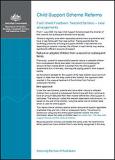Fact sheet Fourteen: Second families - new arrangements
Attachments

From 1 July 2008, the new Child Support Scheme treats the children of first, second and subsequent families more equally.
Tensions regularly arise when separated parents have re-partnered and have a new family with their new partner. Paying parents feel the conflicting pressures of having to support children in two families and, depending on parents' incomes, the children in each family may receive significantly different amounts of support.
Natural or adopted children from a second or subsequent family
Previously, a parent's responsibility towards natural or adopted children from a subsequent family was taken into account by increasing the amount of their income which is exempt from the child support assessment and, in this way, reducing the paying parent's child support liability.
As the amount allowed for the support of the new children could be much higher or lower than the likely costs of the children, this approach often resulted in the unequal treatment of the children from first and subsequent families.
New approach
Under the new Scheme, parents who have either natural or adopted children from a second or subsequent family living with them continue to have an amount deducted from their income before their child support is calculated. The amount called the relevant dependent child amount is based on the cost of the children, using the same cost of children table which is used for child support.
This means that all children receive similar amounts of support regardless of whether they are from a first or subsequent family. The amount is worked out using only the child support parent's income. For more information about the costs of children see Fact sheet Ten: The new child support formula and the costs of children.
Because parents' incomes are treated the same under the new formula, either parent can have children from a new family recognised in this way.
Step-children
Second or subsequent families often include children who are not biologically related to the parent of the child support children. The principle of the Child Support Scheme is that step-children should receive financial support from their absent biological parent, offsetting the contribution of the child support parent.
However, not all biological parents are in a position to contribute to the support of their child. The child's absent parent may be deceased, unknown, not locatable or unable to earn an income. In these cases, the child support parent is actually supporting their step-child.
Previously, a child support parent could only have their child support payment reduced if a court ordered that they have a responsibility to support their step-child. However, in practice, the courts rarely made such orders where the parent was living with their step-child. Alternatively, a child support parent was able to apply for a change of assessment on the basis that they were earning additional income to benefit a biological or step-child living in their household.
New approach
From 1 July 2008, the new Scheme allows either the receiving or paying parent to apply for a change of assessment on the basis that they are responsible for financially supporting a step-child. To have the responsibility taken into account, the parent must be able to demonstrate, amongst other things, that the biological parents of the step-child cannot support the child because of death, ill-health that prevents the parent from working or their caring responsibilities for example, caring for a young child or an older child with disabilities.
Please note this fact sheet is for general guidance only. It should not be treated as a complete or authoritative legal statement.
More details about these changes can be found in other fact sheets and on the Child Support Agency website.
More information on the Taskforce and how the reforms started is available on this website under Ministerial Taskforce on Child Support.
Last updated:
